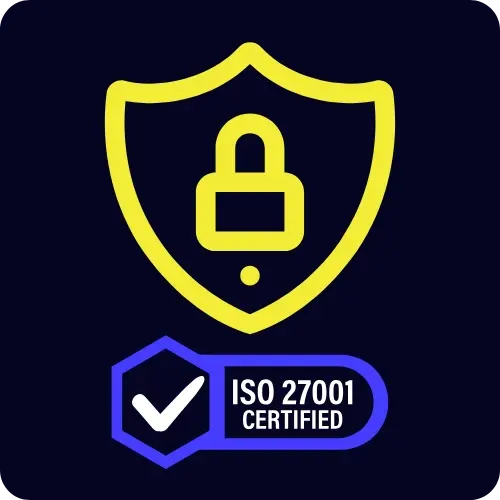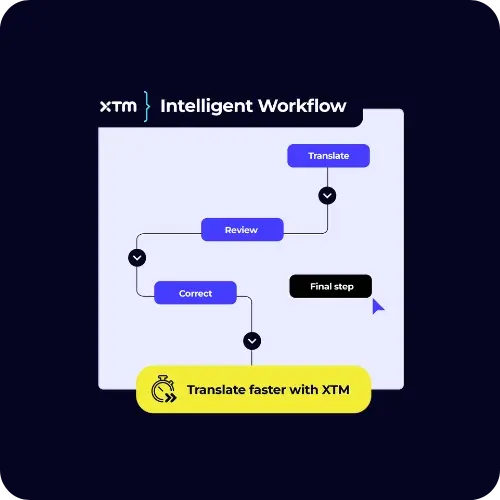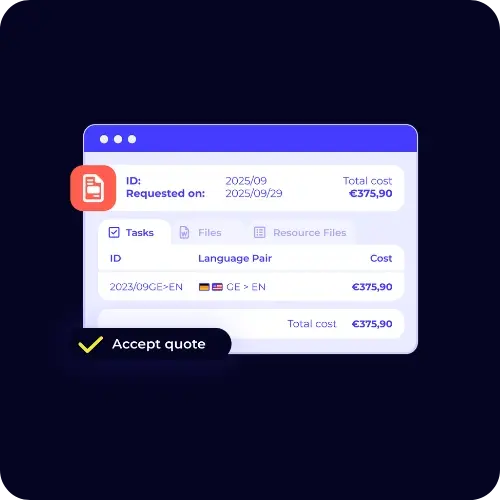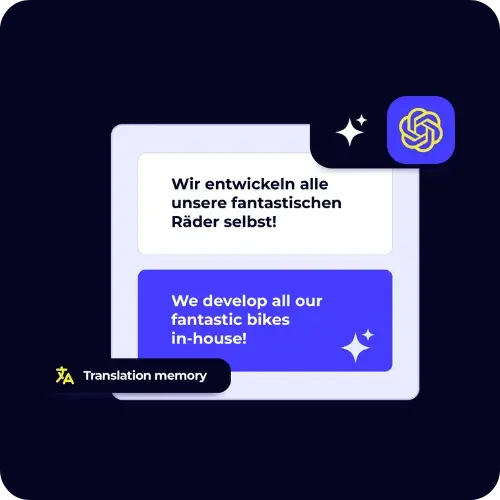XTM vs Phrase
Outgrown Phrase? Step up to XTM Cloud
Designed for enterprise localisation, XTM gives you the power, control, and flexibility Phrase can’t.

Book your personalised demo
Book your personalised demo
Enterprise translation management with transparent pricing and flexible deployment
Phrase works well for developer teams needing basic software localisation with GitHub integrations. But enterprise teams discover limitations quickly when scaling beyond simple app strings. XTM delivers comprehensive translation management with visual context for complex documents, flexible deployment options, and transparent pricing that excludes ICE matches — typically saving 30% compared to Phrase's inflated word counts.
Here are three reasons why XTM wins
Transparent pricing that actually saves money
XTM excludes ICE matches from processed word volumes, typically saving customers 30% compared to Phrase's pricing model that charges for all match types including perfect matches and repetitions. Our transparent licensing means predictable costs without surprise charges as your program scales.
Visual context across all content types
XTM provides real-time visual previews for 65+ file formats including InDesign, PDF, XML, and marketing materials. Translators see exactly how content appears in final layouts with preserved formatting. Phrase only offers basic UI string previews through Phrase Strings without comprehensive visual support.
Flexible deployment for any security requirement
XTM offers public cloud, private cloud, and on-premises deployment options with ISO 27001 certification across all models. This flexibility meets strict compliance requirements for regulated industries. Phrase operates SaaS-only without private cloud or on-premises options for data sovereignty needs.
What's the difference between XTM and Phrase?
Both platforms handle translation management, but they serve completely different organisational scales and requirements. Phrase targets developer teams with API-first architecture for software localisation. Strong GitHub and Figma integrations, modern interface, perfect for teams translating apps and web content with straightforward workflows.
XTM tackles the complex reality of enterprise localisation across departments and content types. Marketing campaigns, legal documentation, technical manuals, multimedia content — all with sophisticated workflow automation, visual context, and integrated financial management. While Phrase keeps things developer-focused, XTM provides the depth and business controls that enterprise teams require as localisation scales.
Here's a side-by-side comparison
XTM vs Phrase - Visual context and complex document support
Visual context transforms translation quality by showing translators exactly how content appears in final layouts, designs, and user interfaces. Enterprise teams handle diverse content types requiring sophisticated preview capabilities beyond simple app strings.
How Phrase handles visual context and documents
Phrase focuses primarily on software strings with basic visual context through Phrase Strings for UI elements. The platform offers limited preview capabilities without comprehensive support for complex file formats like InDesign, PDF, multimedia content, or marketing materials with sophisticated layouts.
How XTM delivers comprehensive visual document support
XTM's visual mode provides real-time WYSIWYG previews for over 65 file formats, from marketing brochures in InDesign to technical documentation in XML and DITA. Translators see exactly how content appears in final layouts whilst preserving formatting, design integrity, and brand consistency.
This comprehensive visual support handles everything from simple HTML pages to sophisticated design files, multimedia content, and structured documentation. Marketing teams can localise complex campaigns, technical writers can manage structured content, and legal teams can handle compliance documents — all with complete visual confidence.
XTM's visual context and document support include:
- Real-time previews for InDesign, PDF, XML, DITA, and multimedia content
- Marketing material support with design integrity and brand consistency maintained
- Technical documentation with structured content visualisation and formatting preservation
- Complex document handling with layout preservation across different languages
- Multimedia support including video subtitles and interactive content localisation

XTM vs Phrase - Enterprise deployment and security flexibility
Deployment flexibility determines how organisations implement translation management whilst meeting security, compliance, and data sovereignty requirements. Enterprise teams often require specific hosting arrangements that standard SaaS cannot provide.
.webp?width=300&height=300&name=3%20(1).webp)
How Phrase handles deployment and security
Phrase operates exclusively as Software-as-a-Service on public cloud infrastructure. All customer data and translation projects run on shared cloud resources without private hosting options. This approach works for standard business requirements but creates challenges for highly regulated industries or companies with specific security mandates.
How XTM provides deployment flexibility for enterprise needs
XTM offers multiple deployment models to meet diverse enterprise security requirements. Public cloud provides standard setup, private cloud delivers dedicated infrastructure with enhanced security controls, and on-premises installation ensures complete data sovereignty for highly regulated industries.
All deployment options include identical feature sets with ISO 27001 certification, ensuring consistent user experience regardless of hosting choice. Private cloud deployments provide customisable security controls, whilst on-premises installations offer maximum data control for healthcare, finance, and legal industries.
XTM's enterprise deployment advantages include:
- Public cloud for standard enterprise requirements with global accessibility
- Private cloud with dedicated infrastructure and customisable security controls
- On-premises installation for maximum data sovereignty and regulatory compliance
- Hybrid configurations combining multiple deployment models for complex organisational needs
- ISO 27001 certification ensuring enterprise security standards across all deployment options

XTM vs Phrase - Workflow automation and business process integration
Workflow automation determines how translation projects move through complex organisational processes involving multiple departments, approval chains, and quality requirements. Enterprise teams need sophisticated automation that adapts to established business procedures.
How Phrase manages workflows and automation
Phrase provides workflows designed primarily for software localisation and development teams. Content flows through basic translation, review, and publish stages without complex routing or approval mechanisms. These workflows lack flexibility for enterprise processes involving multiple departments, compliance requirements, or sophisticated quality gates.

How XTM enables sophisticated workflow automation for enterprise scale
XTM's workflow editor allows organisations to create complex automation matching exact business processes across departments and content types. Teams design custom approval chains, implement quality gates based on content risk, and set up automatic routing based on content type, language, or compliance requirements.
The drag-and-drop workflow designer enables sophisticated automation without technical expertise. Different content types follow unique paths ensuring marketing materials receive brand review, legal content follows compliance procedures, and technical documentation meets quality standards before publication.
XTM's enterprise workflow automation capabilities include:
- Drag-and-drop workflow designer for custom business processes across departments
- Multi-stage approval chains with role-based permissions and escalation rules
- Automated routing based on content type, risk level, and quality requirements
- Integration capabilities with external systems for seamless business process flow
- Real-time monitoring with performance analytics and bottleneck identification across workflows

XTM vs Phrase - Financial management and vendor control
Financial management helps enterprise teams track localisation costs, manage vendor relationships, and demonstrate program value across departments and regions. Integrated financial tools eliminate manual processes whilst providing business intelligence for strategic decisions.

How Phrase approaches financial management and vendor coordination
Phrase focuses on translation workflows without built-in financial management features. Organisations must manually track vendor payments, project costs, and budget allocation using separate systems. This approach creates administrative overhead as localisation programs scale across multiple departments, regions, and content types.

How XTM integrates comprehensive financial control
XTM includes sophisticated financial management directly within translation workflows. The platform automatically generates purchase orders when vendors accept projects, tracks costs in real-time across all languages and content types, and provides detailed analytics on localisation spending with vendor performance metrics.
Business intelligence dashboards show translation memory leverage impact on costs, vendor efficiency ratings, and program ROI calculations. Project managers demonstrate program value through automated reporting whilst maintaining complete budget visibility and cost control across complex enterprise localisation programs.
XTM's financial management and vendor control features include:
- Automatic purchase order generation with vendor billing and approval workflow integration
- Real-time cost tracking with detailed budget analytics across projects, languages, and departments
- Translation memory leverage reporting showing cost savings and efficiency gains over time
- Vendor performance metrics including delivery times, quality scores, and cost effectiveness analysis
- Comprehensive ROI dashboards with automated reporting for demonstrating localisation program value

XTM vs Phrase - Translation memory and terminology optimisation
Translation memory and terminology management ensure consistency whilst reducing costs through intelligent content reuse. Enterprise teams require sophisticated asset management that works across projects, departments, and content types with advanced optimisation capabilities.
How Phrase handles translation assets and terminology
Phrase provides basic translation memory with a single TM for all products, creating challenges for organisations managing different product lines or content types with varying tone and terminology requirements. The platform offers simple glossary functionality without advanced terminology management or cross-project optimisation.

How XTM maximises translation asset value across enterprise content
XTM's advanced translation memory includes AI-enhanced fussy matching that identifies relevant content even when segments don't match exactly. Cross-project leverage means previous translations benefit all future work regardless of project boundaries, departments, or content types.
Concept-based terminology management goes beyond simple glossaries with visual context for terms, automatic validation during translation, and cross-project consistency enforcement. The system ensures brand consistency whilst helping translators understand exactly how terms should be used in different contexts and content types.
XTM's translation memory and terminology optimisation include:
- AI-enhanced fussy matching for improved content reuse and significant cost reduction
- Cross-project leverage maximising value from all previous translation work across departments
- Concept-based terminology management with visual context and automatic validation
- Smart reuse suggestions based on content similarity and translation confidence levels
- Asset optimisation tools showing leverage rates and cost impact across enterprise programs




